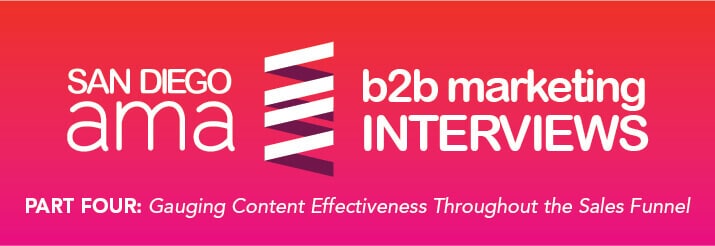The B2B content marketing goals differ over the course of a sale. In the fourth and final part of an interview by the SD AMA, Jeremy Durant of Bop Design shares how content for B2B businesses can be measured for effectiveness.
The interview was conducted by Jimmy Page, Vice President of Content and Analytics at the San Diego Chapter of the American Marketing Association for This Week in Marketing, powered by wsRadio.com. To hear the recordings, visit the SD AMA website.
Jimmy Page: We’re talking today about the marketing funnel, and the B2B process, marketing and sales funnel, and how content applies to it and changes as you go down through it. We’ve talked about high-to-mid funnel content all the way through the end to presumably where the sales team would take over and close the deal. We want to talk now about measurement, and looking at things after the fact. Not just measurement for analysis of what has happened, but also for clients that we’ve just closed, how we can make sure to upsell, and those kinds of things. What methods do we need to be watching to gauge content effectiveness throughout the funnel?
Jeremy Durant: One thing you’ve always got to look at is additional questions, or confusion, of your process, or your product or service. If there are questions that you have addressed through content; maybe it’s the way the content is delivered. Maybe there actually needs to be more handholding. Some may be questions that you have not addressed through any content. It’s great, actually, when you get questions like that because you’re like “Hey, now I know what I need to start blogging about, and then re-purposing as a white paper guide or resource on our site.” You’re just really looking for those customer comments upfront in the sales process, and then also you want to have closed loop feedback where not only are you looking at content marketing on the sales side but once they’re a customer on the customer service side. I want to have closed loop feedback as a Biz-Dev person with our customer service team where there are different expectations with the customer that may need to be addressed on the sales side so that the customer service agent can do their job better because they’ve already been primed in the sales process with the right content. They know what to expect once they become a client.
Jimmy Page: Obviously, marketers are always trying to tag RLI to what they’re doing in terms of spend. A lot of times it can cost quite a bit of money to create this content. In terms of internal collaboration, you might be working with agencies or creative like Bop Design. In an effort to try to attribute revenue, or bottom line, or something like that to single pieces of content. How are people doing that? I assume there are methodologies for trying to say “It was worth it to try and create this piece of content throughout the funnel.”
Jeremy Durant: A pure RLI can be if you’re advertising a particular piece of content. Let’s say you’re using LinkedIn sponsor updates where you are going after a particular function area, a particular industry with a piece of content, that you start seeing increase in traffic to the site, increased conversion, and then taking them through the funnel and seeing how many sales are coming out of that. You also, and I hate to say this, want to attribute everything to an RLI, but keep in mind some of the content that you’re going to have on your site is just a pure brand-play.
Keep in mind, somebody is going to come to your website, and the more quantity of content you have, the more pages you have on your site, you seem more established. It’s a superficial thing, but people are like “Oh, their blog has 1500 blog entries. They’ve been around a long time.” That helps, not only from a pure lead gen standpoint, but from a lead nurturing standpoint. People tend to forget that there is just a general branding benefit from content marketing that can be attributed to a particular ad play, or a return on investment.
No different than everything you do. You know, your office, and where it is, and how it’s decorated, to the way you present yourself; how you dress. You’ve got to look at that stuff. That’s all branding, and that helps get sales, but you can’t really attribute an RLI to that.
However though, I will say that if you are really concerned about that you need to advertise this content. I think a lot of people think, with social media marketing, that it’s all just that organic play. That “Hey, you’re just posting content out, gaining organic followers. You really should pay to play. Utilize, on the B2B front, Twitter and LinkedIn to promote this content out.” I’m not a big fan anymore of pure advertising; of just advertising your firm. People only pay attention when there’s something in it for them. So, utilizing your thought leadership content, get it in front of them, and hey, they see it is sponsored by you, they get to your website, and then they pick up the phone.
So, if you’re really concerned about that do the ad-play, but obviously you’re still going to have it on your site, and it has more benefits than just that isolated ad-play.
Jimmy Page: Yeah, and even as you get down the funnel you can do things like look at what clients, or potential clients. It could be existing clients, could be prospects, that are consuming a certain piece of content and say, “This is the propensity for a client to close who has consumed XYZ pieces of content versus someone who hasn’t.” And probably put some science around that if you have enough volume in an organization. Say this is a single-touch point that we noticed. When it is a single-touch point in a sales process it actually changes the statistics of things to be more favorable to the revenue line at the end of the day. I think those things are really interesting too.
Looking inside of a specific piece of content, thinking about one piece of content, and you guys obviously building content for people; all types of content, from blog posts to very in-depth case studies. How are you testing and looking at how to optimize what’s actually inside of it. How do you know what pieces of a piece of content are really resonating with someone?
Jeremy Durant: Good question. It’s hard, especially with most of our content pieces that we do for ourselves or our clients are pdfs, to see, once they are in that content, what they are looking at. I know this isn’t a real metric driven, this is more of just hearing comments from prospects of “Hey that is really helpful.” Or “You know that piece there that I read. That was really good.” You kind of need to mark that down somehow. It’s really hard to see in a particular piece of content what somebody is looking at. Obviously you can see, when somebody is on a website, if they’re viewing this particular page versus that page or that piece of content. You can tell that, but once they are in a piece of content it can be a little harder.
One thing I do like to talk about, especially in the B2B space, I strongly, with measurement, encourage all B2B firms to do AB testing with gated versus de-gated content. I think people are onto the drill now, especially busy people, that they’re going to fill out a form to get some pieces of content off a website. They know they’re going to be hounded by a salesperson for months. When you’re a busy person, “I know this drill, I’m not stupid. This content looks really good, but do I want to be avoiding phone calls and emails for months telling them ‘no, no, no’?” They understand that. I like to, with certain bits of content, having that same piece of content maybe as gated versus de-gated. My thing is, especially in proprietary, it has taken so long to create this piece of content. Get it in front of as many people as possible. Why make people jump through another hoop. The ideal situation is: they read that piece of content, and hey, there is a call to action at the end of that piece of content. Then they contact you.
I always want to get off my website more active leads versus passes leads. I always think of someone that fills out a form to access content is a passive lead. Yeah, they may still be interested, but guess what. Most of the time that they fill out that form and read the content, guess what they do next. They turn into an active lead because then they fill out my contact form, and their ready to talk to me. That’s an active lead.
I’d rather get that content in front of them and turn that into an active lead versus turning them off with that form, or just getting a passive lead.
Get an overview of B2B content marketing and how to measure the success of your content through the phases of the sales funnel in Part I of this content marketing interview with the SD AMA.



